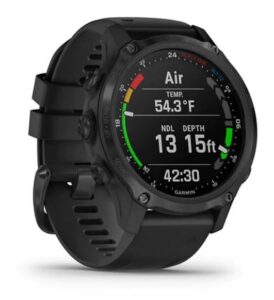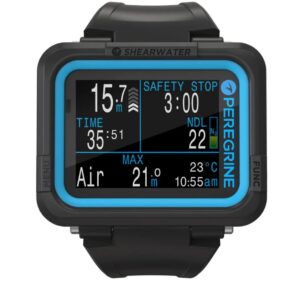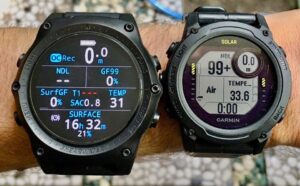Choosing A Dive Computer
June 19, 2023
As an experienced diver, I’m often asked questions on which dive computer I’d recommend, or which is the best dive computer? The answer isn’t necessarily straight forward and depends on a number of factors – so let’s dive into it!
TLDR (Too Long Didn’t Read) Summary
For those that don’t wish to read the full article: Budget aside, here are my recreational starting point suggestions based on the divers mindset:
- Suunto Zoop Novo – “I just want to dive and see cool stuff”
- Garmin Mk2S – “I want to track my fitness, as well as dive”
- Shearwater Peregrine – “I want to see and understand the science of what’s going on behind the scenes of my dives”
The computers listed above each have a more advanced (and higher priced) models available, offering extra features and functionality, allowing the diver to expand their diving capabilities, though as a primary computer for technical diving I would only recommend Shearwater for a number of reasons mentioned below.
The longer explanation…
Choosing the right dive computer from the sea of options out there can seem a little daunting. There are a dozen or so manufacturers and models on the market ranging from budget friendly to eye-wateringly expensive. To a new diver (or even some of us more experienced divers) it might not be inherently obvious what the differences are across the spectrum available to buyers. One might assume that a higher priced computer is “better” than a lower priced alternative, and whilst that might be true in certain situations, it doesn’t necessarily mean the highest priced computer will do the best job.
What kind of diver are you?
This is the first avenue I explore before answering the question, as in my opinion it’s the most important factor. Normally, a relatively new diver will be asking my opinion and as such I adjust the conversation to ask “What kind of diving do you want to do?”. This is crucial to understand because although most dive computers will (for a new diver) do the job so to speak, there are often limitations on the lower priced models and we want to avoid buying a computer only to change it shortly later because our diving progressed to a level beyond the computer’s capabilities.
Recreational Vs Technical Diving
All of us start our journey as a recreational diver (in fact you could argue anyone diving for pleasure is a recreational diver) however, most if not all training agencies out there agree that diving within no-decompression limits (NDL) and to a maximum depth of 40m (There are some other factors in determining recreational Vs technical but we’ll keep it simple for the purposes of choosing a dive computer). Outside of these limits, in order to stay safe, we must consider and plan for a number of additional technical factors, generally increasing in complexity as we increase the depth and duration of the dive, as well as equipment to support the more demanding needs of the environment. Hence the name Technical Diving, but I guess we could call it “Complicated Diving” to summarise for anyone unsure. For those of us that have explored the limits of recreational diving and want to expand our skills and experience to dive outside of those limits, technical diving is the next step – however the rate at which (or if) we arrive at this point will vary across individuals.
It’s also worth noting that in my opinion there is a realm in between – those that dive within recreational limits but still want to understand the nuts and bolts of what is happening behind the scenes when it comes to the physics and science of diving. I will briefly mention this later.
So how does all this affect our computer choice? Dive computers aimed at the recreational diver generally only contain the hardware capabilities and software features for that specific environment, be that depth rating, configurable gasses or decompression programming. Technical dive computers on the other hand contain those same “basic” features, but with upgraded hardware and software to accommodate for the more demanding and complex needs of the technical diver. With these upgrades inevitably comes an “upgrade” in price, and some recreational divers may find the extra information and configuration options a little daunting and overkill for the kind of diving they partake in.
Price
As discussed above, recreational computers tend to be a little friendlier on the wallet compared to their more advanced technical bigger brothers. Having said that, Garmin recently entered the diving market with their Descent series, which includes a plethora of non-diving related features pulled in from their other product lines, and hence a price premium accordingly, but as we’ll see later, a generalist is not always a specialist.
Where do we start?
To narrow the options down a little, I normally suggest investigating three computers initially: Suunto’s Zoop Novo, Garmin’s Mk2S and Shearwater’s Peregrine. Each model is a good starting point and allows for some progression, and I will also mention their more advanced counterparts for the more demanding diver, though for technical diving I recommend Shearwater. With that being said, let’s look at each computer in more detail:
Suunto Zoop Novo

This is a rugged recreational (Nitrox enabled) “puck style” dive computer with a nice big display. It presents with a keep it simple approach and minimalistic monochrome display with audible alarms feature. I personally trained with this dive computer for my Open Water and Deep Dive specialties and as a new diver with less than 20 or so dives, I found it very easy to get the hang of. There’s no Bluetooth connectivity but you can download dive logs using the USB cable, however at the time I was still using paper based logs so transcribing the information across manually was no issue for me. This strictly a recreational dive computer and although it has a Nitrox mode, you are restricted to a single gas and computer “lock-outs” if you violate decompression obligations etc. For more advanced diving such as technical, consider the Suunto Eon Steel, though admittedly I’m not a fan (nor do I have any experience) of using Suunto for Technical diving (see Shearwater later). The battery lasts a couple of years and should be swapped out at the service interval.
I’d summarise the Suunto Zoop Novo as being a good fit for the diver who plans on sticking purely to recreational diving and has no interest in progressing their diving or understanding beyond – which is perfectly acceptable by the way. The price point is very acceptable too, coming in at a much lower cost than the Garmin or Shearwater.
Garmin Descent Mk2S

Garmin are relatively new comers to the diving industry with their Descent Mk1 being released in 2017. The Descent range incorporates Garmin’s well known fitness and activity features seen in their other watches as well as dive features all in a rugged body capable of handling the physical pressure of the diving environment. For the purposes of this article I will ignore the fitness specific details and focus on the diving related aspects only. One of the latest models of the Descent range, the Mk2S sits nicely in the middle of the range from a price point of view. This computer is capable of Nitrox, multi-gas and Trimix and is rated down to 100m – more than enough for most technical divers (and recreational divers of course). It features a full colour screen as well as a digital compass and vibrate / audible alerts. The dive screens offer some customisation in terms of information displayed, and more recently Garmin have started to introduce some technical data available to display (such as SurfaceGF) – though admittedly they are still quite far behind Shearwater in this regard (see next section). Garmin offers their dive app to synchronise dive logs via Bluetooth to your mobile device, offering further insight into some technical data from the dive including heart rate and GPS entry/exit points (which is actually pretty cool). The Mk2S’s bigger brother, the Mk2i offers the same functionality but with added air integration – note however that it is only compatible with Garmin’s proprietary transmitter. The Mk2S sports an internal rechargeable battery but note that you must use Garmin’s (again proprietary) USB charging clasp which can be problem if you lose or forget to bring on a trip. Battery life ranges depending on usage out of the water but as a rough guide the community seems to be getting around 10-15 dives before needing a charge.
In summary, the Garmin Descent Mk2S is a great all rounder offering a generous amount of information relating to the dive as well as the vast array of fitness related features outside of diving. If you want a device to track fitness as well as dive, this is certainly a computer to strongly consider. At the time of writing, Garmin also offer the Descent G1 and Mk2i, both sitting at either side of the Mk2S in terms of price.
Shearwater Peregrine

Shearwater are renowned for their long standing reputation of delivering powerful technical dive computers, as well as rock solid customer support, however, up until recently, many recreational divers had probably never heard the words “Shearwater” & “computer” together . This is beginning to change, as back in 2020, the company released its first dive computer aimed more towards the recreational market – the Peregrine. Offering a large full colour LED backlit screen, Nitrox & 3 gas mix support as well as the trusted ZHL-16C algorithm, and rated down to 120m in its rugged Ballistic Nylon Polymer Case, the Peregrine certainly lives up to Shearwaters reputation for delivering quality dive computers. The display and software are identical to the higher priced technical computers (although Trimix / Closed circuit are absent) and as a result the data layout can be completely customised to include as much technical information as you could possibly dream of. Vibration alerts are available (note no audible) and a cool trick I learned was to change the default font colour from white to green, resulting in a traffic light system ranging from green, yellow to red and the resulting severity. The peregrine sports an internal Li-ion battery which supports wireless charging with the included charger, or 3rd party wireless chargers. As a result of the larger computer size Shearwater were able to fit a stronger battery resulting in more than 30 dives from personal experience, depending on screen brightness and dive lengths etc. Dive logs are downloaded via Bluetooth to the Shearwater app (3rd party apps are also supported) resulting in even more detailed information being available for post dive analysis. Features lacking compared to other models are the obvious Trimix & CC modes, air integration and digital compass. Divers wanting these features may wish to check out the Peregrine’s bigger brother (Perdix 2) or if looking for a watch style, the Teric with its vibrant AMOLED screen. I actually started out with the Peregrine as my first computer but ultimately upgraded to the Teric for AI and compass.
Wrapping it up
I’d recommend the Shearwater Peregrine (and accompanying models) for anyone who sees themselves becoming (or has the mindset) of an advanced diver, and beyond. The Peregrine is rock solid from the ground up, with only a couple of features removed to differentiate from its more advanced technical siblings. The option to remove the strap and use shock cord is a cool feature, something I miss with my Teric. Back when I purchased my Peregrine (with only around 18 dives to my name at the time) I had no idea what all the information being logged in the background related to. Fast forward to present day, with a vast amount of experience in the water and accompanying theory and training, I’m able to look back at my early dive logs to critique bad choices and gain insight into just how far the journey has been from a novice diver to present day – and remember, we are all still on a learning journey! The Peregrine may not have the features of some of its fitness orientated competitors, but for diving it performs VERY well.
A final question I get asked – What computer do I use?
I’m always glad when I’m asked this question, as it gives me the opportunity to explain my decision making process and ethos when it comes to diving:
 For my primary computer, I run a shearwater Teric on my right wrist. As you’ve probably guessed from previous information, I’m a big shearwater fan, and my mentality of using the information given to me by the dive computer to make decisions (as a pose to just following the computers instructions) is echoed by Shearwaters approach to software behaviour. Previously I ran the Peregrine solo, but the lack of AI (and wanting a precise SAC rate) led me down the path of upgrading. At the time the Perdix did not support the vibrate function (something I’ve come to love, but do not completely rely on) so I instead moved to the watch sized Teric, which has grown on me a lot since using it for a year or so. Since then the Perdix 2 has been released sporting the vibrate function which I strongly recommend any serious diver consider.
For my primary computer, I run a shearwater Teric on my right wrist. As you’ve probably guessed from previous information, I’m a big shearwater fan, and my mentality of using the information given to me by the dive computer to make decisions (as a pose to just following the computers instructions) is echoed by Shearwaters approach to software behaviour. Previously I ran the Peregrine solo, but the lack of AI (and wanting a precise SAC rate) led me down the path of upgrading. At the time the Perdix did not support the vibrate function (something I’ve come to love, but do not completely rely on) so I instead moved to the watch sized Teric, which has grown on me a lot since using it for a year or so. Since then the Perdix 2 has been released sporting the vibrate function which I strongly recommend any serious diver consider.
For my backup computer (wait, you dive with two computers?) I use a Garmin Descent G1 on my left wrist. This is only used as a backup should my Teric fail and since it runs the same ZHL-16C algorithm, the decompression procedures and ceilings are identical (provided that you configure it correctly) to my Teric. This was the primary driving factor behind a second computer, but I also wanted a fitness tracker I could take diving and not have to worry about flooding – hence two problems were solved at the same time. The display is nowhere near as pretty as the Teric and as mentioned previously, the in-dive information falls far short of Shearwaters standards, but it is enough information (depth and deco stops) to get me to the surface safely should any problems arise.
As I venture into the closed circuit rebreather (CCR) world I will need to re-think this computer setup, but that is for another article.

